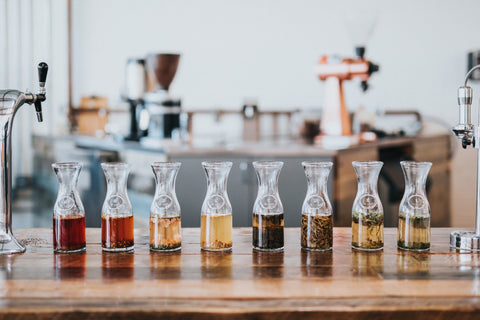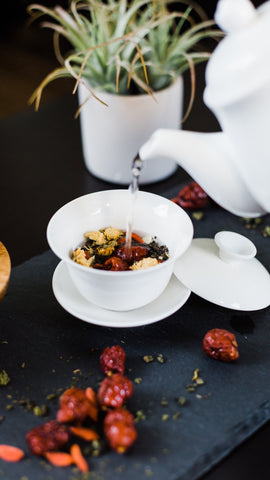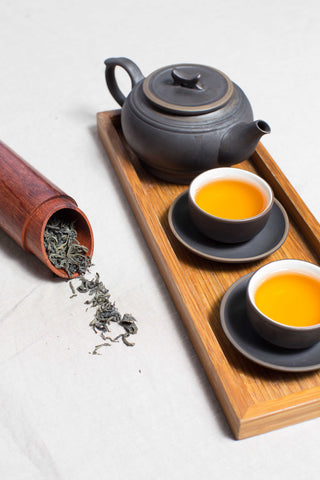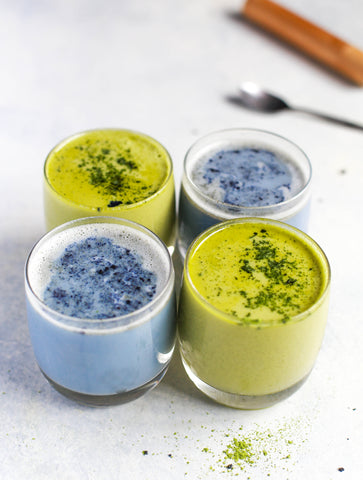Is Tea Fermented?
Commonly referred to throughout the industry, the process referred to as fermentation in tea production is actually a different chemical process, known as oxidation. Meanwhile some tea-based beverages employ natural fermentation in their production.
As a result, while awareness is growing for the impact of fermentation in coffee, fermentation in tea is still a confusing topic for many drinkers.
We explore the difference between regular fermentation of tea-based beverages and oxidation in tea.
Fermented or Not? That Is the Question!
Fermentation, a natural process involving microbes, has traditionally been used in food preparation and beverages to create a range of health and flavor benefits.
Fermentation in food and beverages employs microscopic organisms such as yeasts and other beneficial bacteria to convert one substance into another using a specific set of conditions depending on the desired output.
Microbes colonize foodstuffs to derive energy through chemical processes. This results in a host of changes including increasing nutrient bioavailability, nutrient-density, altering a food or beverage's flavor profile or reducing the level of antinutrients.
Kombucha, which is a black or green tea-based sparkling beverage, results from the introduction of live cultures to brewed tea. The resulting beverage is rich in probiotics that maintain gut health, while other potential beneficial qualities have not been scientifically-evaluated.
Other examples of fermented beverages include all alcoholic beverages and Cultured Coffee.
Fermentation versus Oxidation
While fermentation is also referred to in the production of brewed teas, this is inaccurate. Some herbal teas on the market today include probiotic cultures alongside tea leaves to maintain gut health but the tea itself hasn't been fermented.
Most dried teas however don't use live cultures at all during production. Instead, harvested tea leaves undergo a natural chemical process known as oxidation, which also changes the color, flavor and level of health benefits in the resulting brew.

Oxidation occurs when any living material is exposed to oxygen in the air. Unlike fermentation however, oxidation is typically a reductive process, meaning it breaks down rather than enhances the living matter. It also takes place without microbes.
In food and beverages, chemical reactions take place that slowly result in nutrient loss, texture changes and discoloration.
The flavor benefits of oxidation have been harnessed by tea producers for millennia to create different flavor and color profiles in the brewed end product.
Unlike some fermented products like Cultured Coffee, cheese or alcoholic beverages, the exact degree of oxidation in tea is not as controlled and can therefore vary from one batch to another.
Instead, tea producers use a combination of inspection, similar production methods and brewing tests to gauge how much oxidation is in each batch of harvested tea.
Some tea producers will indicate the degree of oxidation in their tea however, which is determined by measuring the quantity of certain compounds produced in tea leaves during oxidation.

Varieties of Tea
Tea, a beverage made by steeping the dried leaves and buds of shrub camelia sinensis in hot water, has been brewed in China and other parts of Asia for millennia.
It was introduced in Europe due to colonial expansion during the 17th Century, eventually becoming a global staple still enjoyed across the world today.
Flavors in tea depend on the exact cultivar, how the plant material is dried and the degree of oxidation. The many varieties of tea on offer today can be grouped into five distinct categories:
While now widely consumed as a healthy pick-me-up, green tea has become a very popular drink around the world as well as being used as an ingredient in cooking.
The first evidence of its preparation as a medicinal drink dates back to 200 BC - 600 AD in China during the Han and Tang dynasties.
Since then its popularity has spread, with many using green tea instead of coffee as a caffeinated but healthy beverage.
To make green tea, fresh tea leaves are steamed then dried (and can be powdered).
This process creates a strong, bright cup that's rich in antioxidant polyphenols as well as vitamin C. The tea also remains unoxidized, which preserves many of the nutrients and stronger grassy flavors of the fresh shrub. However tea (green and otherwise) also contains some antinutrients that can hamper the absorption of any vitamins and antioxidants.
Originating from East Asia, this rare tea is wrapped while damp then gently steamed. The wrapping and more humid preserving process slows the oxidation rate of the tea leaves, which creates a more mellow flavor compared to green tea as well as lending a slightly yellow color to the end brew.
In the Korean peninsula this kind of tea is known as "fermented" or "balhyocha" tea, which is used to denote tea varieties other than green tea (but not fermented, despite the name). The slower oxidation rate may also preserve more of the nutrients in the tea leaves, resulting in a healthier beverage.
 Oolong / White:
Oolong / White:
Unlike green or yellow teas, oolong and white teas are produced by drying tea leaves and buds in the sun then twisting and curling them.
This extra manipulation induces natural oxidation in the tea by breaking cell walls in the leaves and releasing natural enzymes. These enzymes leads to chemical and flavor changes (less "grassy" flavors") compared to green tea.
The oxidation rate in the leaves can vary significantly between 8-85% depending on the exact technique, which is why oolong tea is referred to as "semi-oxidized."
White teas, traditionally made from camelia sinensis buds, are typically less processed than oolong, which preserves their delicate floral aromas.
Since white tea is typically produced from naturally large-leaf shrubs however, each leaf is subject to greater oxygen exposure. This brings white tea's degree of oxidation in line with oolong varieties.
Black:
Black tea (also known as "red tea" in many countries) is a strong flavored tea characterized by the dark color of the dried tea leaves and brew.
Since black tea retains its flavor for much longer than other varieties, this made it ideal for transporting around the world.
As a result many of the first tea drinkers in Europe in the 17th Century and the United States thereafter brewed black tea, which accounts for its enduring popularity in these regions. In these regions black tea is either served on its own, with a slice of lemon or, as in the case of the United Kingdom, typically mixed with milk.

Black tea has traditionally been made from the larger-leafed assamica tea cultivar, though this practice is changing.
It can also include teas dried using heat rather than steam or sun-drying techniques, as is the case with Chinese lapsang souchong, which is made by smoking tea leaves over pine. This imparts a distinct smoky flavor to the tea.
Finally in terms of health, black tea is the most oxidized of the varieties, resulting in fewer vitamins and antioxidants than green tea as well as a higher caffeine content.
Herbal:
Any dried or fresh plant material brewed in hot water other than from camelia sinensis can be referred to as a herbal tea.
While herbal teas can be dried like tea leaves, some shrubs like rooibos from South Africa undergo a similar oxidation process as camelia sinensis. This process is what lends the tea its distinctive amber color and mild flavor.
Herbal teas can have a range of flavors and health benefits depending on the exact mix of herbs. Typically however they're not fermented or mixed with other beverages like milk as in the case of black tea.
We hope you found this overview of fermentation and oxidation in tea useful!
---





Leave a comment
Please note, comments must be approved before they are published